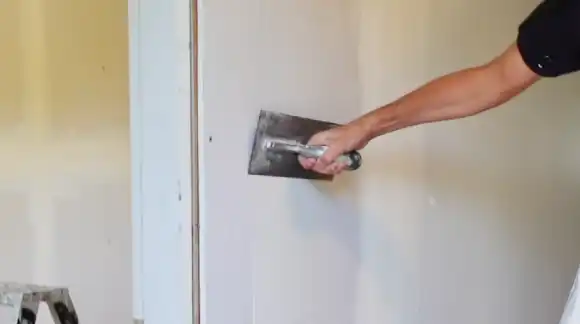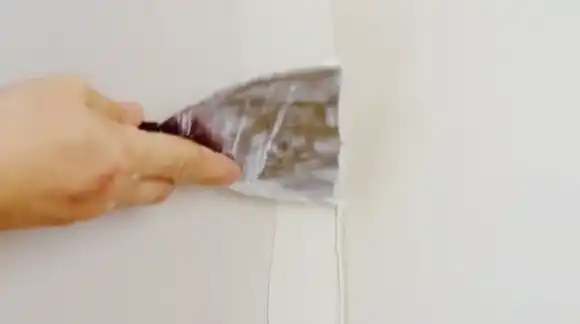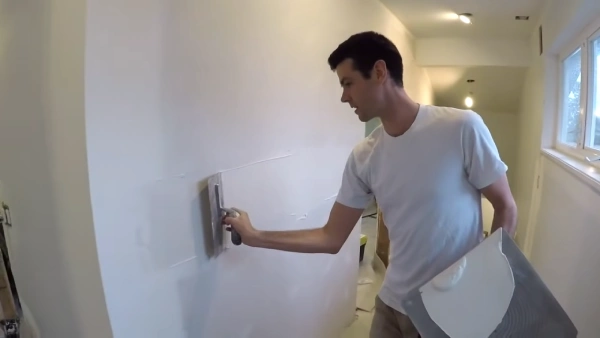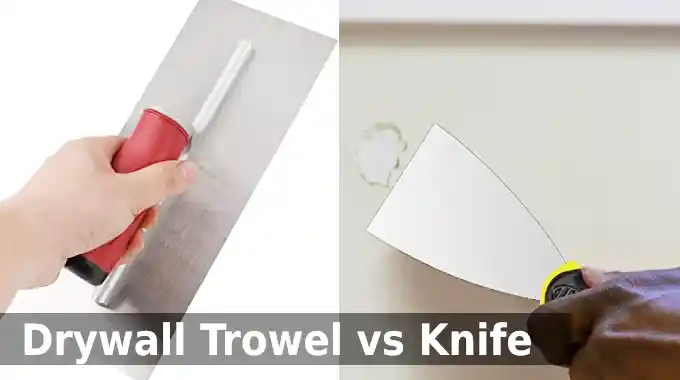Last Updated on January 25, 2023
Drywall trowel or knife? That’s the tricky question. Both options seem useful for unique drywall applications. But understanding the differences between the two is also helpful. Trowels and knives have distinct sizes, dimensions, and applications that suit the user’s needs and working abilities.
Still, there’s a noticeable difference in their design. Drywall trowel blades are generally wider, while drywall knives are usually narrower. They’re also developed for specific purposes. Depending on your application and how you plan to use it, you’ll need to figure out which is right for you.
So, never fear if you can’t choose a drywall trowel or knife. We’re here to help compare the two and shed some light on when a drywall knife may be preferable to a trowel. You’ll find more on this topic in the following article.
Drywall Trowel vs Knife: Discover the Secrets of Handywork

A drywall trowel and knife are two different tools used to construct drywall. They both have their specifications, which are explained in further detail below:
Tools Designing
The drywall trowel is designed with a wide blade, usually made of steel, which spreads wet joint compounds on the wall surface. The handle of the trowel is typically ergonomically designed for comfort and ease of use. It’s also possible to texture the blade’s surface to reduce friction.
Conversely, a drywall knife usually comes as a narrow stainless steel blade with a wood or plastic handle. It has an extended blade that makes reaching tight areas, such as corners or inside corners, easier.
It is also used to apply joint compound onto wall surfaces but primarily to smooth surfaces after applying joint compound to create a smooth finish.
Tool Size & Dimensions
Depending on application needs and desired coverage area, drywall trowels come in sizes ranging from 11 to 18 inches long. Similarly, drywall knives come in various lengths from 4-6 inches, depending on application requirements and user preference.
The widths of both tools vary as well. Trowels range from 4 to 5 inches wide, while knives are available from 2 inches to 5 inches wide for trimming edges or making cuts along edges with precision accuracy.
Overall Usability
A drywall trowel is superior compared to a putty knife when completing projects faster. The trowel’s wide surface area allows more material to be applied with minimal effort, as you can quickly and easily spread the material over large surfaces.
Knives require precision and skill when spreading the material but provide better accuracy in tighter areas or corners where greater control is essential for an even spread. Although smaller than a trowel, knives can still get the job done if used correctly, just slower.
Application Ease
Trowels might not be everybody’s go-to tool, especially in the industrial world, where machines are apt for getting large projects done quickly and consistently.
But when it comes to those smaller tasks that require a more manual touch, a trowel is your friend. It covers more surface area in less time thanks to its quick-start capabilities and large size.
On the other hand, knives can be tedious as their small size often forces users to take extra time applying multiple layers until desired results appear. So if you’re looking for speed and effectiveness, grab that trusty trowel.
Intention of Use
The intention of using a drywall trowel or a knife is mainly to finish off the drywall mudding. A drywall trowel can fill in small gaps and imperfections on walls, creating a smoother and more even surface than a knife.
With the trowel’s flat edge, you can apply joint compound evenly, while the knife helps finish it off by scraping off any excess.
Likewise, a trowel can cover large holes or dents in the wall, while a knife is better for minor cracks or uneven surfaces. But if you want a perfectly smooth corner finish, you’ll need a drywall knife.
User’s Physical Strength
Using either tool involves some physical strength, as both require manipulation and skill to operate properly.
Generally speaking, applying joint compound with a drywall trowel requires less physical effort than using a drywall knife. This is because it is designed for larger areas and has an ergonomic handle, making it easier to hold onto for extended periods.
Moreover, when using a knife, there is also more risk of straining one’s wrist due to its length and sharpness. Still, the shape and size of a drywall trowel allow its users to have more control over their movements without putting too much strain on their wrists or hands.
Damage-prone
Both tools should be handled with care as they can cause damage if used incorrectly or appropriately. When using knives, users must ensure that they are always kept clean and free from debris, as this could result in scratches or gouges on the wall surface when misapplied.
Alternatively, applying too much pressure when using a drywall trowel could lead to deep grooves left behind, which might be harder to fix. Take extra care when working on delicate surfaces like freshly painted walls or wallpaper. These surfaces may be more prone to damage than other areas in your home.
Cost Considerations
Cost should also factor in when determining which tool best suits your needs. Drywall trowels typically cost around five dollars each, while putty knives can range anywhere from two dollars up depending on the quality and size desired.
If you’re going to be completing multiple projects involving these tools, then investing in higher-quality items will likely pay off in terms of longevity since cheaper materials wear down faster after repeated use making them less effective over time.
But if you’re tackling only one job, buying an inexpensive version may be enough for what you need to do without unnecessarily spending too much money.
Benefits of Using Drywall Knife and Drywall Trowel

Using a drywall knife and trowel is a great way to achieve perfect results when working with drywall. Drywall knives are essential for precise mud cuts, while the trowel helps smooth out any joints or seams on the surface. These tools offer numerous advantages that make them ideal for any drywall job.
Drywall knives provide users with increased accuracy and control when cutting into sheetrock walls. The thin blade allows for detailed trimming and precise measurements, giving the user complete control over how much mud is cut away.
Using a drywall trowel also provides several benefits. Its flat shape helps reach tight angles or corners to get an even finish on any joint or seam. This can help create a seamless finish that looks professional. Also, the wide surface area helps to spread mudded seams easily and evenly across a drywall surface.
Perhaps most importantly, both tools help to save time on any type of drywall job by allowing for quick and easy precision cuts and smooth finishes. This means any job can be completed quickly and efficiently without compromising quality or precision results.
Do You Need a Drywall Trowel or Knife for the Drywall Corner?
You need to use a curved drywall corner trowel or a drywall knife when working on the corner of a drywall. Curved corner trowels and knives allow you to get into those tight corners and angles that other tools may not be able to reach properly.
The curved trowel is handy when applying the mud evenly and smoothly in tight spaces, as it has a rounded edge that enables you to reach corners more easily. Meanwhile, the drywall knife will help feather out any excess mud, which is essential for an even finish.
Can I Use a Drywall Trowel Instead of a Drywall Knife?

You can use a drywall trowel if you don’t have a drywall knife. But, depending on the type of job and material involved, there may be instances where it would make more sense to opt for the knife instead.
For instance, if you’re dealing with intricate designs or detailed work, then a knife would probably offer better control over the shape and texture than a trowel could provide. Also, using a trowel will require more time than its counterpart.
What Size is Drywall Trowel Recommended for the Beginner?
For beginners starting with their first drywalling project, it’s best to use one at least 14 inches in length. This size provides enough space between the handle and blade so that both hands can comfortably grip it while avoiding fatigue from prolonged use.
Furthermore, its size allows for better maneuverability around hard-to-reach areas such as corners and edges, making it perfect for all projects. The 14-inch width provides ample coverage when applying mud evenly over larger surfaces like walls and ceilings, ensuring uniform results every time.
Why Are Drywall Trowel Handles Curved?

The handles of drywall trowels are curved to make them comfortable to grip and ease the strain on the wrist when working with the trowel for extended periods. Also, the curved handle reduces slippage, allowing users to maintain better balance and control during use.
This curve handle also helps ensure that pressure is evenly distributed along the length of the trowel as it is pushed against the wall or other surface, making it easier to apply an even layer of the joint drywall compound without having to reposition your hand repeatedly.
Can I Use a Finishing Drywall Trowel for Drywall?
Finishing drywall trowels can be used for drywall smooth finishing in some instances. But don’t use them to achieve a perfectly smooth finish. Trowels are best suited for applying thicker layers of the compound in areas such as corners or where two pieces of drywall meet, and they can also be used when texturing walls or ceilings.
When using finishing trowels for drywall finishing, keep them clean and sharp so that you don’t leave behind unsightly divots on the surface or create other irregularities in your project.
Do I Need a Drywall Taping Knife for Drywall Finishing?

Often, a drywall taping knife is necessary for drywall finishing projects. Taping knives are designed specifically for applying thin layers of joint compound along seams and joints between two pieces of drywall, which makes transitioning between them seamlessly without leaving any gaps or voids.
Also, they have angled blades, making it easier to get into tight corners while avoiding clumping up excess compounds around joins and edges.
Unscramble Your Drywall Project Needs: Trowels vs. Knives
It pays to understand the difference between a trowel and a knife when unscrambling your drywall project needs. Trowels offer great control for spreading joint compounds over larger patches, while knives are perfect for precision cutting and reaching joint compounds to the corner.
And no matter which tool you choose, consider user working strength and cost-efficiency before pulling out your wallet or toolbox. With their particular advantages, trowels and knives can achieve top-notch results when used correctly. Don’t worry. You won’t go wrong with whichever tool you pick.



